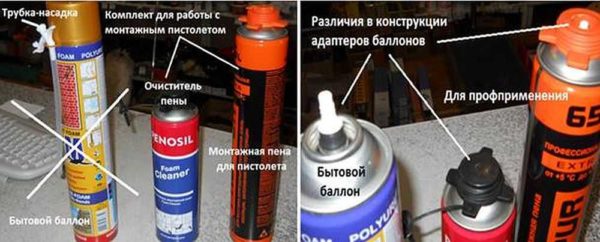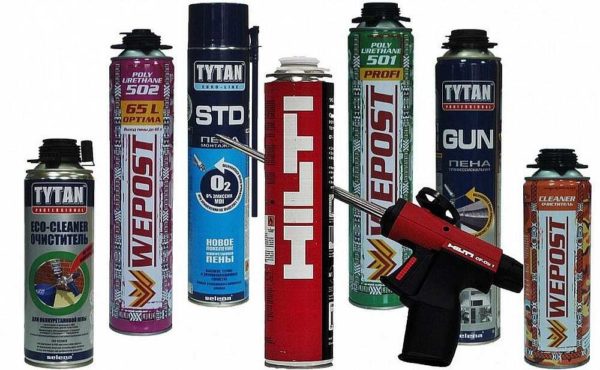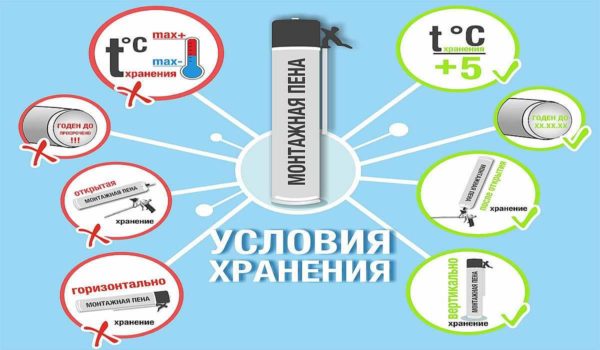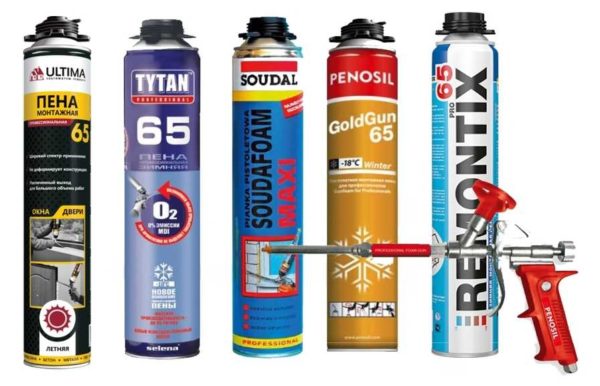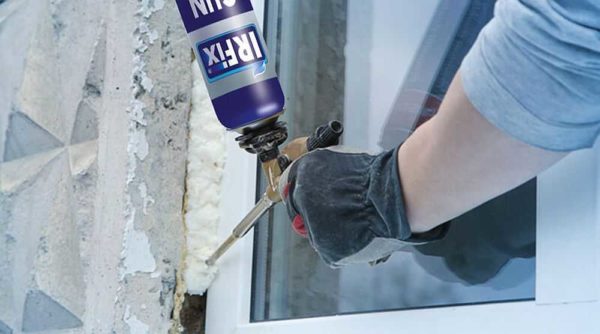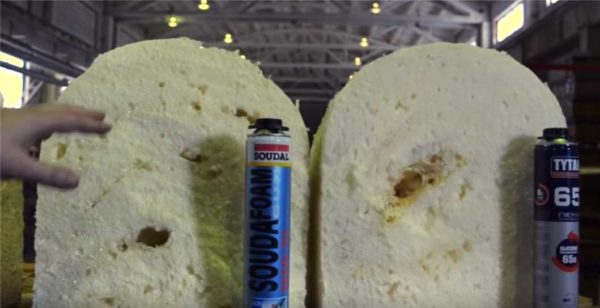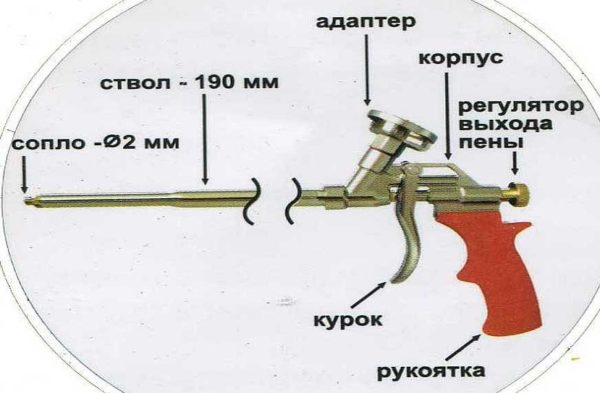The choice of polyurethane foam
To fill in a seam, crack, install a window or door block, glue insulation - for all these works and a dozen others, polyurethane foam is used. If you go to any hardware store, you will see at least a dozen items. And in large or specialized there may be hundreds. Which one should you choose? Which polyurethane foam is better? Depends on conditions, tasks and requirements.
The content of the article
What is polyurethane foam and how is it formed
Polyurethane foam is a foamed polymer that quickly solidifies (polymerizes) in air. Release form - metal cylinders of various sizes. The container contains a prepolymer in a liquid state and a propellant. Substances, which are called "propellant gases", are characterized by the fact that they have a low boiling point. The cylinder is under high pressure. When the outlet valve opens, the compound is pushed into the lower pressure area. The propellant boils upon exiting, creating a large number of air bubbles and inflating the foam.
Further, in air, the resulting foam polymerizes - it becomes tough and hard. Water is required for the curing process, so it is recommended to wet the surfaces before application. Also moisture is taken from the air. Since there is little moisture in the frosty air, there are certain compositions for such conditions.
Properties
Do not confuse polyurethane foam with glue. By the way, there is glue in similar containers, which also foams. But there is a completely different composition and nothing can be reliably glued to the polyurethane foam. It can support / hold in a certain position, but none has the strength of the adhesive bond. So don't be confused. This is not her area of application.
In order to understand correctly where you can use polyurethane foam, you need to know about its properties. They are quite good:
- Mounting property. This is binding, joining, attaching (not gluing) parts of the structure.
- Soundproofing. Polyurethane foam cannot be called sound insulation, but it reduces the noise level.
- Thermal insulation. Due to the large amount of air trapped in thin polymer bubbles, thermal conductivity is reduced.
- Good adhesion to almost all building materials. Cannot be used only with silicone, rubber, and some also with polyethylene.
The main use of construction foam is installation. No wonder it is called polyurethane foam. But as a heater and sound insulation, it is also not bad. Not perfect, but not bad. Filling seams, cracks, sealing / insulating utility bushings - this is its field of application. In this it is difficult for her to find competitors. How did you fill in such gaps before? They were clogged with rags and covered with a solution. Foam in this regard is much more convenient and has better properties.
Important characteristics
Any type of polyurethane foam has two important characteristics - primary and secondary expansion... Primary expansion is how much the mass increases in volume before the end of polymerization. There are foams with both high and low primary expansion. Which polyurethane foam is better - high expansion or low expansion? It will not work out for sure. They are used in different cases. Low expansion foam is good for filling small cavities, as well as for layer-by-layer filling of deep joints, when installing EPS. Large expansion is more advantageous when filling cavities, using as sound insulation, thermal insulation.
Specifically, for window installations and doors, it is better to take foam with a small expansion.Moreover, both primary and secondary. Unfortunately, this is professional foam, so you also need a gun.
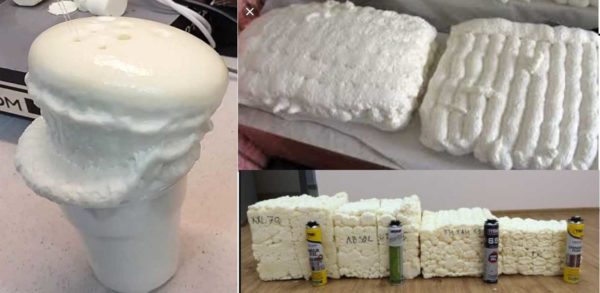
The left image is an illustration of a large secondary expansion. See how the primary framework ripped apart? Well, and the difference between foams in density and "fluidity"
Secondary expansion is the increase in foam volume after the end of the polymerization process. Which polyurethane foam is better for this? Definitely the one with less secondary expansion. Why? Because this process is difficult to predict. And the possible consequences are serious - deformation of flexible or moving parts. For example, window frames or doorframes may buckle if foam builds up. And even the spacers that are placed do not always help.
Why then do you need construction foam with a large secondary expansion? It has its own field of application - filling cavities and cracks in rigid and stable materials and structures. For example, in concrete, as an aggregate with thermal insulation properties between the wall and the brick finish. Foam with a large secondary expansion is cheaper. This is important for large volumes.
Foam outlet
Another thing to pay attention to is the foam release. This is the volume that can come out of the balloon. It is indicated in liters. Generally, the larger the cylinder, the greater the yield. But not always. With the same cylinder size, the yield difference can be about 20-30%. It can be determined by weight. The heavier the cylinder (weight indicated), the greater the yield.
What else is worth knowing that the actual yield of polyurethane foam is usually less than the declared one (more often household types sin this). To ensure the required volume, it is necessary to accurately select the proportions of prepolymer and filler gas. And not all brands can boast of this. Here is a list of those who consistently give out the declared volumes:
- Soudal (Soudal) professional lines (not household).
- Penosil (Penosil) Gold (Gold) and Premium (Premium).
- Moment Installation (very inexpensive and widespread).
- Wellfoam (WellFom).
- Hilti (Hilty).
- Kim Tec (Kim Tec).
- Den Braven (Den Braven).
- Illbruck (Ilbruck).
- Tytan (Titan) (some parties either do not work at all or give out less than half of the declared).
There may be other good brands of construction foam. But it is these, according to the builders, who fail very rarely. When buying, look at production date... After a year, the valve begins to poison, the filler gas comes out, and the output decreases accordingly.
Note! It is necessary to work with polyurethane foam, which has room temperature. In cold weather, you must first warm it up. Even winter or all-season.
Types and application
All cylinders with polyurethane foam can be divided according to the field of application: household and professional. They are also different in appearance. Professional ones are made for a special gun. You can't work without it. Household ones have a pressure valve (like in aerosols) and a long thin tube. Of course, these are not all the differences. There is a difference in properties:
- Curing speed. Professional ones harden faster. Some brands become tough after just 30 minutes. The “normal cure time” is 24 hours. This is how much it is recommended to wait after applying the foam before continuing to work.
- Secondary expansion amount. For professional, it is about 30-50% of the primary volume, for households it can be 130-250%.
- The dimensions of the cavities. Foam consisting of small bubbles is considered good. This is the difference between professional ones, although some household ones also have few large cavities. But they cannot be classified as cheap either.
The most annoying thing on the list is the large secondary extension. Why is that bad? The fact that when foaming windows, door frames, strongly increasing foam can bend wood or profiles.Well, and because it is growing too actively, it is difficult to dose it, which leads to a large overrun. So the difference in price turns out to be quite insignificant as a result. If it stays at all.
When and where to apply these types of polyurethane foam? Household foam is also suitable for filling cavities and holes in rigid structures. For example, Boxer, Ultima, Cosmoflex, Wellfom, Fount. When installing doors and windows, it is best to work with a professional. These are Ilbruk, Penosil, Soudal, Titan.
Types by seasons
Polyurethane foam is also divided according to the temperature regime of application. There are the following types:
- Summer. Apply at positive temperatures, but not lower than + 5 ° C.
- Winter. It can be used in freezing temperatures down to -18 ° C.
- All-season. Its range is declared from -10 ° C to + 35 ° C, but it is optimal to use it somewhere in the region from + 10 ° C to zero. At lower temperatures, winter is better, at higher ones, summer.
In a heated room, we use summer foam, if we foam windows in winter - winter or all-season - depending on the temperature outside. In general, "specialized" shows itself better - summer or winter. They are adapted to certain conditions, and this is always more reliable than the universal version (all-season).
When working in winter, do not leave the foam in the cold. Bring in warm. If it is supercooled, it will be too fluid, will not keep its shape. In general, we always keep the foam warm. And more - more foam comes out of a warm balloon.
Flammability
Polyurethane foam must be selected according to flammability. There are three classes:
- fuel - there is B3 on the cylinder;
- self-extinguishing (no fire, it does not burn) marked with B2;
- non-flammable (even in fire, retains its properties for a certain period of time) is designated by class B1.
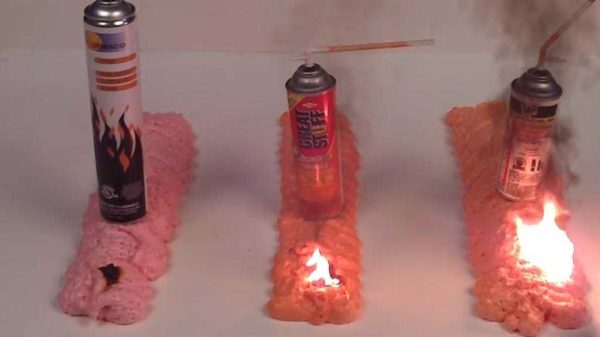
Flammable and non-combustible polyurethane foams. The degree of flammability is indicated by the letter B and numbers from 1 to 3. B1 - non-combustible, B2 - self-extinguishing, B3 - combustible
It is best to use non-combustible construction foam in timber and frame buildings. It should also be used in rooms with increased fire safety requirements. There is such a room in houses - boiler room... Every serious manufacturer has fireproof / non-combustible polyurethane foam. It is necessary to look in a professional line. For example, Tytan B1, Soudal FR, Den Braven (Den Braven), Kim-Tec (Kim Tek).
There are also two-component polyurethane foams. But they harden very quickly, so they are used by professionals, and even then not all. You need work skill, but two-component foam is enough.
Special types
There are some types of jobs that require special properties.
- With increased adhesion to wood. There are different brands, for example, VIK (Vik) professional and household, FOAM 65, AkFix 940.
- Heat resistant. Used to seal chimney outlets. In general, you can take any with a class of fire resistance class B1. Even if it darkens or turns black, it will not lose its properties. Examples: Penosil Fire Rated B1 (marketed as chimney foam), Tytan Professional B1.
- Very fast, almost instant polymerization (eg Soudal 2K). They are used in works at height, when it is impossible to wait even 30 minutes. They are used by industrial climbers during installation and repair work.
- Remain flexible after solidification: AkFix Maximum 65, PROFPUR ELASTICFORCE and others. Such foams are needed in places where there is constant vibration or tensile stress.
These brands are far from the only ones. There are others. Look at serious manufacturers of construction chemicals, read the characteristics, look for reviews. We are already accustomed to the fact that the declared characteristics do not always coincide with reality.
Professional polyurethane foam guns
If you decide to use professional polyurethane foam, you need a gun for it. The range of prices here is large.But for a single use, you can take an inexpensive one. The price does not affect the amount of foam. It's just that the more expensive ones better control the intensity of the foam release, deliver it over a greater distance.
The ability to adjust the flow rate is in any, but the level of control is different. After work, if the cylinder is not empty, it can remain in the gun for 2 weeks or a month. During this period, you can simply continue to work. But to store the "loaded" pistol should be in a warm room, not in the sun.
When replacing the cylinder, if the foam goes well, no additional manipulations are needed. If foam has stopped coming out and the can is not empty, the nozzle may clog. Then the nozzle can be flushed. If the liquid comes out without problems, then the problem is in the cylinder. Usually the propellant runs out prematurely, but copolymer can run out too. After the end of the work, the cylinder is removed, the gun (nozzle) is washed with a solvent (polyurethane cleaner) foam. No other manipulations are required.

